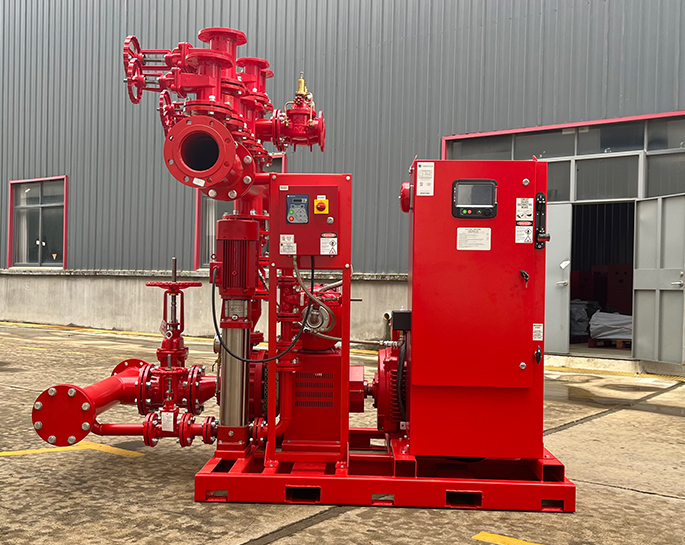What are the considerations for selecting the appropriate instrumentation and monitoring devices for electric fire pump systems?
Apr 09, 2024
Share:
Selecting the appropriate instrumentation and monitoring devices for electric fire pump systems involves several considerations to ensure safety, reliability, and compliance with regulatory standards. Here are some key factors to consider:
1. **System Requirements**: Understand the specific requirements of the electric fire pump system, including its flow rate, pressure ratings, power source, and any applicable codes or regulations (such as NFPA standards).
2. **Reliability**: Choose instruments and devices known for their reliability and durability, as the fire pump system must operate effectively in emergency situations. Components should be resistant to environmental factors such as temperature variations, moisture, and corrosion.
3. **Compatibility**: Ensure that the selected instruments and devices are compatible with the electric fire pump system's components, including the pump itself, motor, control panel, and any other associated equipment.
4. **Accuracy**: Accuracy is crucial for monitoring pressure, flow rate, temperature, and other parameters within the fire pump system. Select instruments with appropriate accuracy levels for the specific requirements of the system.
5. **Remote Monitoring Capability**: Consider whether remote monitoring capabilities are necessary for the electric fire pump system. Remote monitoring allows for real-time monitoring of system performance, alerts for potential issues, and data logging for analysis and troubleshooting.
6. **Alarm and Notification Systems**: Choose instruments and devices equipped with alarm and notification systems to alert operators or building occupants in case of abnormal conditions, such as low pressure, high temperature, or pump failure.
7. **Integration with Building Management Systems (BMS)**: If the building has a BMS in place, ensure that the selected instrumentation and monitoring devices can integrate seamlessly with the existing system for centralized monitoring and control.
8. **Maintenance Requirements**: Consider the maintenance requirements of the instrumentation and monitoring devices. Select devices that are easy to maintain and calibrate, with readily available spare parts and support services.
9. **Cost Considerations**: Balance the cost of the instrumentation and monitoring devices with their quality, reliability, and functionality. While it's essential to stay within budget constraints, prioritize quality and reliability to ensure the safety and effectiveness of the fire pump system.
10. **Compliance with Standards**: Ensure that the selected instruments and devices comply with relevant industry standards and regulations, such as NFPA 20 for the installation of stationary fire pumps.
By carefully considering these factors, you can select the most appropriate instrumentation and monitoring devices for electric fire pump systems to ensure their safe and reliable operation in protecting life and property during fire emergencies.

1. **System Requirements**: Understand the specific requirements of the electric fire pump system, including its flow rate, pressure ratings, power source, and any applicable codes or regulations (such as NFPA standards).
2. **Reliability**: Choose instruments and devices known for their reliability and durability, as the fire pump system must operate effectively in emergency situations. Components should be resistant to environmental factors such as temperature variations, moisture, and corrosion.
3. **Compatibility**: Ensure that the selected instruments and devices are compatible with the electric fire pump system's components, including the pump itself, motor, control panel, and any other associated equipment.
4. **Accuracy**: Accuracy is crucial for monitoring pressure, flow rate, temperature, and other parameters within the fire pump system. Select instruments with appropriate accuracy levels for the specific requirements of the system.
5. **Remote Monitoring Capability**: Consider whether remote monitoring capabilities are necessary for the electric fire pump system. Remote monitoring allows for real-time monitoring of system performance, alerts for potential issues, and data logging for analysis and troubleshooting.
6. **Alarm and Notification Systems**: Choose instruments and devices equipped with alarm and notification systems to alert operators or building occupants in case of abnormal conditions, such as low pressure, high temperature, or pump failure.
7. **Integration with Building Management Systems (BMS)**: If the building has a BMS in place, ensure that the selected instrumentation and monitoring devices can integrate seamlessly with the existing system for centralized monitoring and control.
8. **Maintenance Requirements**: Consider the maintenance requirements of the instrumentation and monitoring devices. Select devices that are easy to maintain and calibrate, with readily available spare parts and support services.
9. **Cost Considerations**: Balance the cost of the instrumentation and monitoring devices with their quality, reliability, and functionality. While it's essential to stay within budget constraints, prioritize quality and reliability to ensure the safety and effectiveness of the fire pump system.
10. **Compliance with Standards**: Ensure that the selected instruments and devices comply with relevant industry standards and regulations, such as NFPA 20 for the installation of stationary fire pumps.
By carefully considering these factors, you can select the most appropriate instrumentation and monitoring devices for electric fire pump systems to ensure their safe and reliable operation in protecting life and property during fire emergencies.







